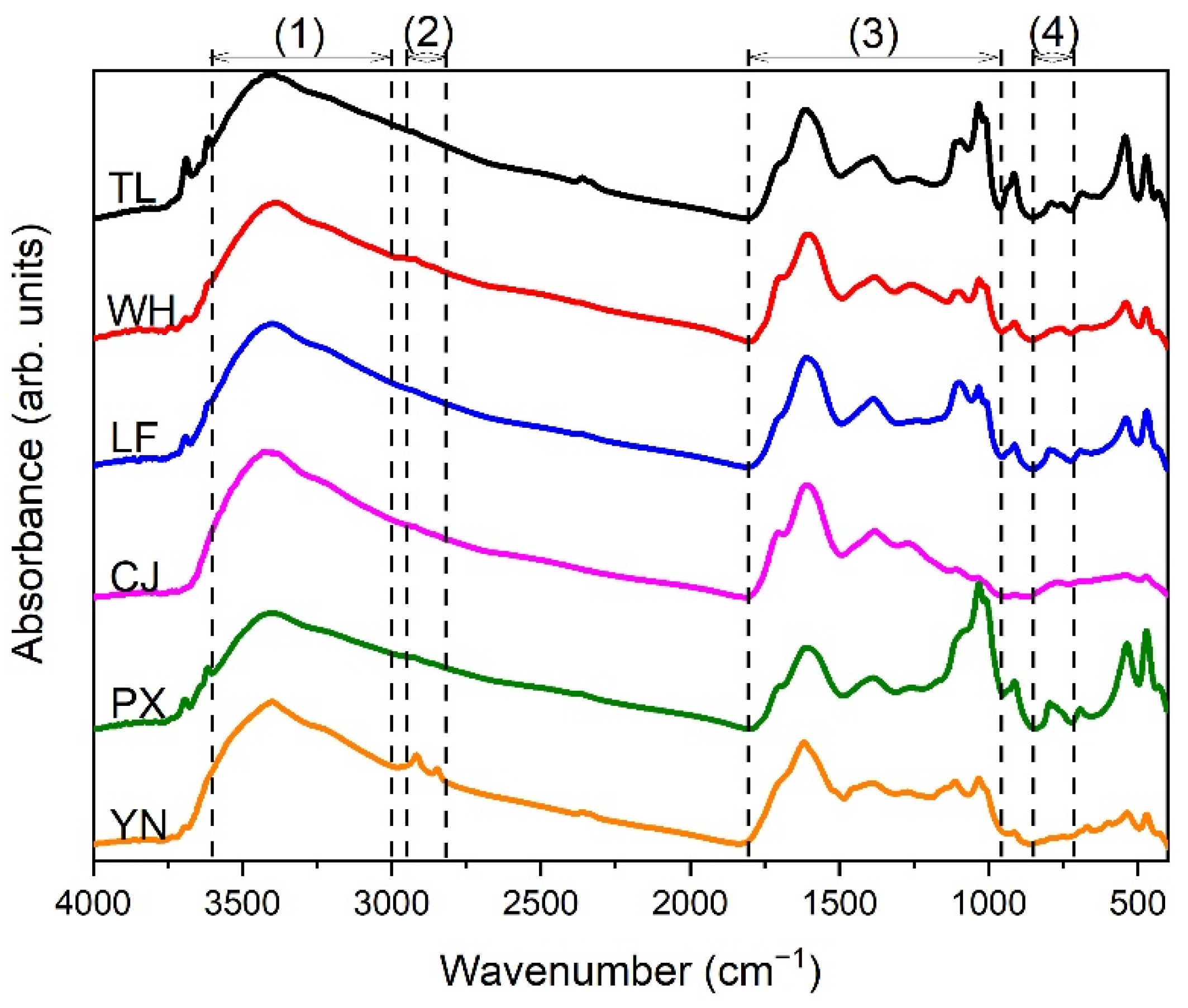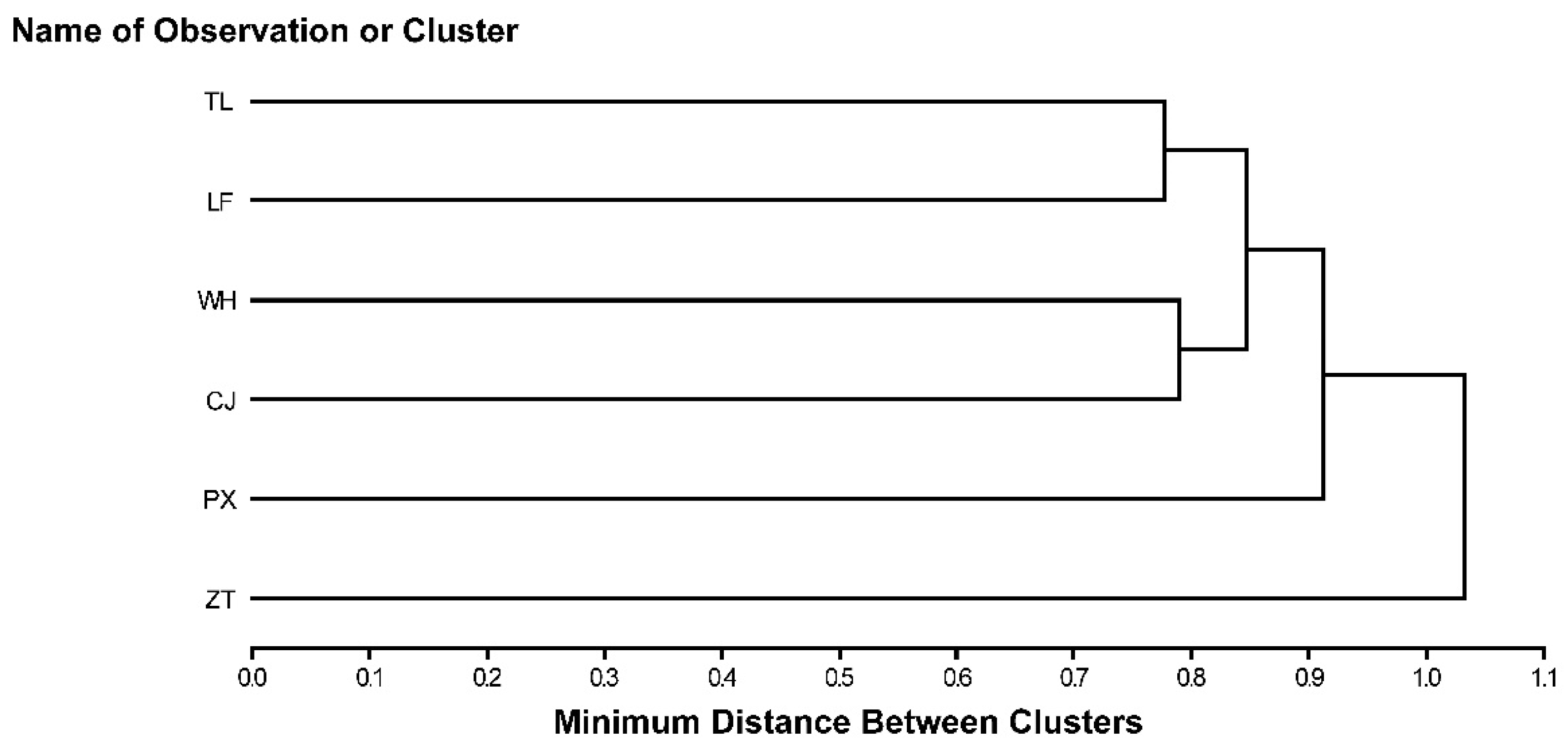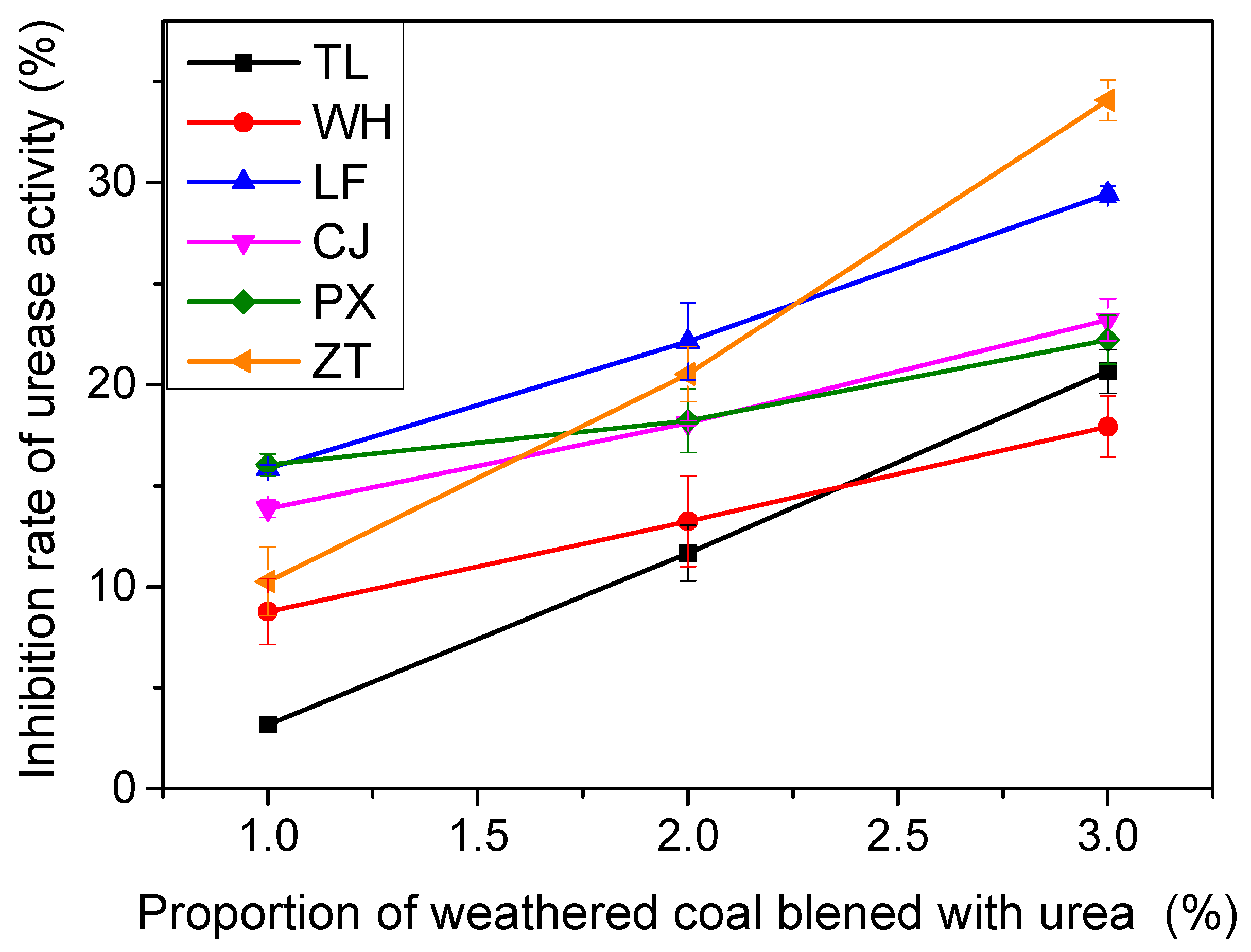Characteristics of Chinese Weathered Coal from Six Geographical Locations and Effects on Urease Activity Inhibition
Abstract
:1. Introduction
2. Materials and Methods
2.1. Collection and Processing of Weathered Coal
2.2. Conventional Chemical Analysis of Weathered Coal
2.3. FTIR Spectroscopy of Weathered Coal
2.3.1. FTIR Measurements
2.3.2. FTIR Spectral Processing
2.3.3. Calculation of FTIR Parameters
2.4. Preparation of Materials for Assay of Urease Activity
2.4.1. Preparation of Urea Containing Weathered Coal
2.4.2. Preparation of Soybean Meal Urease
2.4.3. Assay of Urease Activity
3. Results and Discussion
3.1. Proximate and Ultimate Analysis
3.2. Conventional Chemical Analysis
3.3. FTIR Analysis of Weathered Coal
3.3.1. Global FTIR Characteristics of Weathered Coal
3.3.2. Curve-Fitting of the FTIR Spectra
3.3.3. Structural Parameters from the FTIR Spectra
3.4. Cluster Analysis of Weathered Coal
3.5. Inhibition of Weathered Coal on Urease Activity
4. Conclusions
Supplementary Materials
Author Contributions
Funding
Institutional Review Board Statement
Informed Consent Statement
Data Availability Statement
Conflicts of Interest
References
- Zheng, P. The Application and Production of Coal Humic Acids; Chemical Industry Press: Beijing, China, 1991. [Google Scholar]
- Li, S.; Dou, X. Current situation and forecast for the utilization of weathered coals. Coal Chem. Ind. 1996, 1, 1–4. [Google Scholar]
- Yuan, L.; Huang, T.; Wang, G.; Wang, X. Effects of humic acid and humic organic fertilizer on nutrient allocation and fertilizer use efficiency of maize. Chin. Agric. Sci. Bull. 2014, 30, 98–102. [Google Scholar]
- O’Keefe, J.M.K.; Bechtel, A.; Christanis, K.; Dai, S.; DiMichele, W.A.; Eble, C.F.; Esterle, J.S.; Mastalerz, M.; Raymond, A.L.; Valentim, B.V.; et al. On the fundamental difference between coal rank and coal type. Int. J. Coal Geol. 2013, 118, 58–87. [Google Scholar] [CrossRef]
- Sun, Z.; Li, W.; Du, H.; Zhang, G. Effect of weathered coal with different source on the activation of iron in soil. Humic Acid 2003, 4, 11–14. [Google Scholar]
- Liu, Y.; Lu, W.; Zhang, F.; Feng, M.; Wang, L. Effect of weathered coal in different regions on corn germination. Humic Acid 2015, 4, 21–24. [Google Scholar]
- Ferm, M. Atmospheric ammonia and ammonium transport in Europe and critical loads: A review. Nutr. Cycl. Agroecosyst. 1998, 51, 5–17. [Google Scholar] [CrossRef]
- Zaman, M.; Nguyen, M.L.; Blennerhassett, J.D.; Quin, B.F. Reducing NH3, N2O and NO3-N losses from a pasture soil with urease or nitrification inhibitors and elemental S-amended nitrogenous fertilizers. Biol. Fertil. Soils 2008, 44, 693–705. [Google Scholar] [CrossRef]
- Matczuk, D.; Siczek, A. Effectiveness of the use of urease inhibitors in agriculture: A review. Int. Agrophys. 2021, 35, 197–208. [Google Scholar] [CrossRef]
- Bollmann, A.; Laanbroek, H.J. Continuous culture enrichments of ammonia-oxidizing bacteria at low ammonium concentrations. FEMS Microbiol. Ecol. 2001, 37, 211–221. [Google Scholar] [CrossRef]
- Sun, J.; Mei, B.; Shen, J.; Griffith, D.W.T.; Denmead, O.T.; Hill, J.; Shu, K.L.; Mosier, A.R.; Chen, D. Effects of lignite application on ammonia and nitrous oxide emissions from cattle pens. Sci. Total Environ. 2016, 565, 148–154. [Google Scholar] [CrossRef]
- Sun, G. Effect of mixed application of urea and weathered coal. Soil 1976, 4, 47–49. [Google Scholar]
- Gao, S.; Wang, B.; Han, Y. Effects of humic acid and its raw materials on soil urease activity and nitrogen. Humic Acid 2004, 6, 32–36. [Google Scholar]
- Lu, X.; Wang, S.; Wang, H.; Wang, Y. Study on new types of urease inhibitors. Acta Pedol. Sin. 1997, 4, 461–466. [Google Scholar]
- Kołodziej, B.; Sugier, D.; Bielińska, E. The effect of leonardite application and various plantation modalities on yielding and quality of roseroot (Rhodiola rosea L.) and soil enzymatic activity. J. Geochem. Explor. 2013, 129, 64–69. [Google Scholar] [CrossRef]
- Sugier, D.; Kołodziej, B.; Bielińska, E. The effect of leonardite application on Arnica montana L. yielding and chosen chemical properties and enzymatic activity of the soil. J. Geochem. Explor. 2013, 129, 76–81. [Google Scholar]
- Institute of Coal Chemistry Chinese Academy of Science. Chemical property and structural analysis of humic acid. Humic Acid 1995, 4, 24–34. [Google Scholar]
- Zhang, S.; Yuan, L.; Li, W.; Lin, Z.; Li, Y.; Hu, S.; Zhao, B. Characterization of pH-fractionated humic acids derived from Chinese weathered coal. Chemosphere 2017, 166, 334–342. [Google Scholar] [CrossRef]
- Silverstein, R.M.; Webster, F.X.; Kiemle, D.J.; Bryce, D.L. Spectrometric identification of organic compounds, 8th edition. J. Chem. Educ. 1981, 92, 826–827. [Google Scholar]
- Ibarra, J.; Muñoz, E.; Moliner, R. FTIR study of the evolution of coal structure during the coalification process. Org. Geochem. 1996, 24, 725–735. [Google Scholar] [CrossRef]
- Wang, S.; Tang, Y.; Schobert, H.H.; Guo, Y.N.; Su, Y. FTIR and 13C NMR investigation of coal component of late permian coals from Southern China. Energy Fuels 2011, 25, 5672–5677. [Google Scholar] [CrossRef]
- Jia, X.; Zhong, Y.; Liu, J.; Zhu, G.; Yan, W. Effects of nitrogen enrichment on soil microbial characteristics: From biomass to enzyme activities. Geoderma 2020, 366, 114256. [Google Scholar] [CrossRef]
- Li, K.; Khanna, R.; Zhang, J.; Barati, M.; Liu, Z.; Xu, T.; Yang, T.; Sahajwalla, V. Comprehensive investigation of various structural features of bituminous coals using advanced analytical techniques. Energy Fuels 2015, 29, 7178–7189. [Google Scholar] [CrossRef]
- Painter, P.C.; Rimmer, S.M.; Snyder, R.W.; Davis, A. A Fourier transform infrared study of mineral matter in coal: The application of a least squares curve-fitting program. Appl. Spectrosc. 1981, 35, 102–106. [Google Scholar] [CrossRef]
- Wang, S.H.; Griffiths, P.R. Resolution enhancement of diffuse reflectance i.r. spectra of coals by Fourier self-deconvolution: 1. C-H stretching and bending modes. Fuel 1985, 64, 229–236. [Google Scholar] [CrossRef]
- Li, W.; Zhu, Y. Structural characteristics of coal vitrinite during pyrolysis. Energy Fuels 2014, 28, 3645–3654. [Google Scholar] [CrossRef]
- Li, Z.; Wei, X.; Yan, H.; Zong, Z. Insight into the structural features of Zhaotong lignite using multiple techniques. Fuel 2015, 153, 176–182. [Google Scholar] [CrossRef]
- Dutta, S.; Hartkopf-Fröder, C.; Witte, K.; Brocke, R.; Mann, U. Molecular characterization of fossil palynomorphs by transmission micro-FTIR spectroscopy: Implications for hydrocarbon source evaluation. Int. J. Coal Geol. 2013, 115, 13–23. [Google Scholar] [CrossRef]
- Xin, H.H.; Wang, D.M.; Qi, X.Y.; Qi, G.S.; Dou, G.L. Structural characteristics of coal functional groups using quantum chemistry for quantification of infrared spectra. Fuel Process. Technol. 2014, 118, 287–295. [Google Scholar] [CrossRef]
- Iglesias, M.J. FTIR study of pure vitrains and associated coals. Energy Fuels 1995, 9, 458–466. [Google Scholar] [CrossRef]
- Chen, Y.; Mastalerz, M.; Schimmelmann, A. Characterization of chemical functional groups in macerals across different coal ranks via micro-FTIR spectroscopy. Int. J. Coal Geol. 2012, 104, 22–33. [Google Scholar] [CrossRef]
- Enev, V.; Sedláček, P.; Kubíková, L.; Sovová, Š.; Doskočil, L.; Klučáková, M.; Pekař, M. Polarity-Based sequential extraction as a simple tool to reveal the structural complexity of humic acids. Agronomy 2021, 11, 587. [Google Scholar] [CrossRef]
- He, X.; Liu, X.; Nie, B.; Song, D. FTIR and Raman spectroscopy characterization of functional groups in various rank coals. Fuel 2017, 206, 555–563. [Google Scholar] [CrossRef]
- Ibarra, J.; Moliner, R.; Bonet, A.J. FT-i.r. investigation on char formation during the early stages of coal pyrolysis. Fuel 1994, 73, 918–924. [Google Scholar] [CrossRef]
- Botero, W.G.; Oliveira, L.C.D.; Rocha, J.C.; Rosa, A.H.; Santos, A.D. Peat humic substances enriched with nutrients for agricultural applications: Competition between nutrients and non-essential metals present in tropical soils. J. Hazard. Mater. 2010, 177, 307–311. [Google Scholar] [CrossRef]
- Li, L.; Zhao, Z.; Huang, W.; Peng, P.; Fu, J. Characterization of humic acids fractionated by ultrafiltration. Org. Geochem. 2004, 35, 1025–1037. [Google Scholar] [CrossRef]
- González-Pérez, M.; Torrado, P.V.; Colnago, L.A.; Martin-Neto, L.; Otero, X.L.; Milori, D.M.B.P.; Gomes, F.H. 13C NMR and FTIR spectroscopy characterization of humic acids in spodosols under tropical rain forest in southeastern Brazil. Geoderma 2008, 146, 425–433. [Google Scholar] [CrossRef]
- Chen, Y.; Senesi, N.; Schnitzer, M. Information provided on humic substances by E4/E6 ratios. Soil Sci. Soc. Am. J. 1977, 41, 352–358. [Google Scholar] [CrossRef]
- Kyoichi, K.; Osamu, S.; Yasuo, O.; Shinobu, O. Humus composition of mountain soils in Central Japan with special reference to the distribution of P type humic acid. Soil Sci. Plant Nutr. 1967, 13, 151–158. [Google Scholar]
- Liu, X.; He, X. Effect of pore characteristics on coalbed methane adsorption in middle-high rank coals. Adsorpt.-J. Int. Adsorpt. Soc. 2017, 23, 3–12. [Google Scholar] [CrossRef]
- Mathews, J.P.; Chaffee, A.L. The molecular representations of coal—A review. Fuel 2012, 96, 1–14. [Google Scholar] [CrossRef]
- Kister, J.; Guiliano, M.; Largeau, C.; Derenne, S.; Casadevall, E. Characterization of chemical structure, degree of maturation and oil potential of Torbanites (type I kerogens) by quantitative FT-i. r. spectroscopy. Fuel 1990, 69, 1356–1361. [Google Scholar] [CrossRef]
- Mastalerz, M.; Bustin, R.M. Application of reflectance micro-Fourier transform infrared spectrometry in studying coal macerals: Comparison with other Fourier transform infrared techniques. Fuel 1995, 74, 536–542. [Google Scholar] [CrossRef]
- Zhang, S.; Yuan, L.; Li, Y.; Zhao, B. Characterization of ultrafiltration-fractionated humic acid derived from Chinese weathered coal by spectroscopic techniques. Agronomy 2021, 11, 2030. [Google Scholar] [CrossRef]
- Ganz, H.; Kalkreuth, W. Application of infrared spectroscopy to the classification of kerogentypes and the evaluation of source rock and oil shale potentials. Fuel 1987, 66, 708–711. [Google Scholar] [CrossRef]
- Saha, B.K.; Rose, M.T.; Wong, V.; Cavagnaro, T.R.; Patti, A.F. Hybrid brown coal-urea fertiliser reduces nitrogen loss compared to urea alone. Sci. Total Environ. 2017, 601–602, 1496–1504. [Google Scholar] [CrossRef] [PubMed]
- Wang, J.; Wu, J.; Lu, J.; Yuan, G. Effects of leonardite on the coastal saline soil improvement. Chem. Ecol. 2020, 36, 750–765. [Google Scholar] [CrossRef]
- Li, H.; Shao, H.; Li, W.; Bi, R.; Bai, Z. Improving soil enzyme activities and related quality properties of reclaimed soil by applying weathered coal in opencast-mining areas of the Chinese Loess Plateau. Clean-Soil Air Water 2012, 40, 233–238. [Google Scholar] [CrossRef]
- Marzadori, C.; Francioso, O.; Ciavatta, C.; Gessa, C. Activity and stability of jack bean urease in the presence of peat humic acids obtained using different extractants. Biol. Fertil. Soils 2000, 32, 415–420. [Google Scholar] [CrossRef]
- Li, Y.; Tan, W.; Koopal, L.K.; Wang, M.; Liu, F.; Norde, W. Influence of soil humic and fulvic acid on the activity and stability of lysozyme and urease. Environ. Sci. Technol. 2013, 47, 5050–5056. [Google Scholar] [CrossRef]
- Green, S.A.; Morel, F.M.M.; Blough, N.V. Investigation of the electrostatic properties of humic substances by fluorescence quenching. Environ. Sci. Technol. 1992, 26, 294–302. [Google Scholar] [CrossRef]
- Dong, L.; Yang, J.; Yuan, H.; Wang, E.; Chen, W. Chemical characteristics and influences of two fractions of Chinese lignite humic acids on urease. Eur. J. Soil Biol. 2008, 44, 166–171. [Google Scholar] [CrossRef]
- Polano, M.; Anselmi, C.; Leita, L.; Negro, A.; De, N.M. Organic polyanions act as complexants of prion protein in soil. Biochem. Biophys. Res. Commun. 2008, 367, 323–329. [Google Scholar] [CrossRef] [PubMed]
- Rao, M.A.; Russo, F.; Granata, V.; Berisio, R.; Zagari, A.; Gianfreda, L. Fate of prions in soil: Interaction of a recombinant ovine prion protein with synthetic humic-like mineral complexes. Soil Biol. Biochem. 2007, 39, 493–504. [Google Scholar] [CrossRef]
- Sarkar, J.M. Formation of [14C]cellulase-humic complexes and their stability in soil. Soil Biol. Biochem. 1986, 18, 251–254. [Google Scholar] [CrossRef]



| Sample | Geographical Location | Proximate Analysis 1 (%) | Ultimate Analysis 1 | |||||||
|---|---|---|---|---|---|---|---|---|---|---|
| Moisture | Ash | Content (%) | Atomic Ratio | |||||||
| C | H | N | O 2 | H/C | O/C | N/C | ||||
| TL | Tongliao, Inner Mongolia | 13.0 | 34.2 | 52.5 | 2.60 | 1.06 | 43.8 | 0.59 | 0.63 | 0.02 |
| WH | Wuhai, Inner Mongolia | 15.8 | 18.6 | 66.4 | 2.94 | 1.15 | 29.5 | 0.53 | 0.33 | 0.01 |
| LF | Linfen, Shanxi | 23.0 | 31.3 | 52.2 | 2.22 | 1.09 | 44.5 | 0.51 | 0.64 | 0.02 |
| CJ | Changji, Xinjiang | 28.3 | 12.4 | 57.7 | 2.16 | 1.00 | 39.2 | 0.45 | 0.51 | 0.01 |
| PX | Pingxiang, Jiangxi | 18.4 | 40.6 | 45.7 | 3.57 | 0.57 | 50.1 | 0.94 | 0.82 | 0.01 |
| ZT | Zhaotong, Yunnan | 10.0 | 19.1 | 54.5 | 4.61 | 1.06 | 39.9 | 1.02 | 0.55 | 0.02 |
| Variation coefficient 3 (%) | 33.9 | 38.3 | 11.1 | 52.4 | 16.1 | 16.4 | 55.0 | 25.2 | 33.3 | |
| Sample | pH Value | E4/E6 | ΔlogK | Humic Acid (%) | Exchange Capacity (mmol/g) | Acidic Functional Groups (mmol/g) | ||
|---|---|---|---|---|---|---|---|---|
| Total Acidic Groups | Carboxylic Groups | Phenolic Hydroxyl Groups 1 | ||||||
| TL | 4.92 | 3.48 | 0.53 | 39.6 | 2.46 | 4.48 | 1.13 | 3.35 |
| WH | 5.16 | 3.48 | 0.57 | 46.6 | 2.79 | 3.90 | 1.01 | 2.89 |
| LF | 5.16 | 3.68 | 0.57 | 33.8 | 2.48 | 4.10 | 0.48 | 3.62 |
| CJ | 5.11 | 3.60 | 0.56 | 45.3 | 2.87 | 4.63 | 1.18 | 3.45 |
| PX | 4.73 | 3.47 | 0.57 | 27.6 | 2.47 | 3.37 | 0.70 | 2.67 |
| ZT | 4.24 | 4.64 | 0.68 | 36.8 | 2.90 | 4.39 | 0.63 | 3.76 |
| Variation coefficient 2 (%) | 6.70 | 11.2 | 8.09 | 17.1 | 7.31 | 10.2 | 31.0 | 11.8 |
| Sample | fa1 | AR1 2 | AR2 2 | Ahy/Aet2 | ACH2/ACH32 | AC=O/AC=C2 | A Factor 2 | C Factor 2 |
|---|---|---|---|---|---|---|---|---|
| TL | 0.97 | 13.0 | 8.75 | 4.75 | 5.29 | 0.71 | 0.58 | 0.42 |
| WH | 0.90 | 1.93 | 1.85 | 2.16 | 9.36 | 0.58 | 0.63 | 0.37 |
| LF | 0.98 | 12.8 | 16.3 | 11.5 | 8.05 | 0.40 | 0.72 | 0.28 |
| CJ | 0.97 | 10.7 | 6.21 | 1.66 | 4.43 | 0.33 | 0.75 | 0.25 |
| PX | 0.95 | 3.80 | 8.74 | 3.11 | 3.17 | 0.47 | 0.68 | 0.32 |
| ZT | 0.49 | 0.67 | 0.12 | 2.17 | 3.12 | 0.66 | 0.60 | 0.40 |
| Variation coefficient 3 (%) | 21.6 | 78.9 | 82.6 | 88.2 | 46.5 | 28.3 | 10.6 | 20.6 |
Publisher’s Note: MDPI stays neutral with regard to jurisdictional claims in published maps and institutional affiliations. |
© 2022 by the authors. Licensee MDPI, Basel, Switzerland. This article is an open access article distributed under the terms and conditions of the Creative Commons Attribution (CC BY) license (https://creativecommons.org/licenses/by/4.0/).
Share and Cite
Zhang, S.; Yuan, L.; Li, Y.; Zhao, B. Characteristics of Chinese Weathered Coal from Six Geographical Locations and Effects on Urease Activity Inhibition. Agronomy 2022, 12, 1531. https://doi.org/10.3390/agronomy12071531
Zhang S, Yuan L, Li Y, Zhao B. Characteristics of Chinese Weathered Coal from Six Geographical Locations and Effects on Urease Activity Inhibition. Agronomy. 2022; 12(7):1531. https://doi.org/10.3390/agronomy12071531
Chicago/Turabian StyleZhang, Shuiqin, Liang Yuan, Yanting Li, and Bingqiang Zhao. 2022. "Characteristics of Chinese Weathered Coal from Six Geographical Locations and Effects on Urease Activity Inhibition" Agronomy 12, no. 7: 1531. https://doi.org/10.3390/agronomy12071531
APA StyleZhang, S., Yuan, L., Li, Y., & Zhao, B. (2022). Characteristics of Chinese Weathered Coal from Six Geographical Locations and Effects on Urease Activity Inhibition. Agronomy, 12(7), 1531. https://doi.org/10.3390/agronomy12071531





